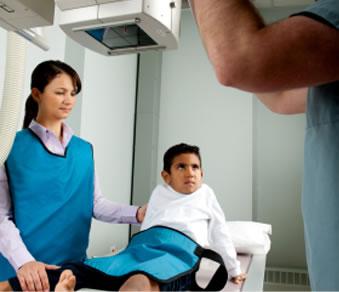November 11, 2013 — The U.S. Food and Drug Administration (FDA) has approved three new pediatric
fluoroscopy educational modules developed by an Image Gently, Society for Pediatric Radiology/Alliance for Radiation Safety in Pediatric
Imaging workgroup for distribution.
“Image Gently: Enhancing Radiation Protection in Pediatric Fluoroscopy” is a free resource that provides radiologic technologists with practice-based information and instructions on how to reduce radiation exposure during pediatric fluoroscopic imaging. The modules cover enhancing radiation protection in pediatric fluoroscopy, managing radiation dose during examinations and managing radiation dose and possible tissue effects after procedures. In addition to serving as a resource for radiologic technologists, the modules provide educational resources for secondary audiences such as radiologists and medical imaging physicists.
The project is a result of a competitive contract issued by the FDA in 2011. The FDA sought a group of pediatric radiology experts to develop a template for targeted instructions and testing materials to promote the safe use of fluoroscopic devices when working with children. Following a selection process, the FDA chose a workgroup from the Society for Pediatric Radiology/Alliance for Radiation Safety in Pediatric Imaging to develop the educational modules. The team included medical imaging experts from the American Society of Radiologic Technologists (ASRT), Society for Pediatric Radiology (SPR) and American Association of Physicists in Medicine (AAPM), all members of the Image Gently initiative.
In addition to the educational modules, the team provided the FDA with a series of additional deliverables designed to help radiologic science professionals improve radiation protection procedures when working with children:
- A report that summarizes educational resources and gaps in radiation protection training for radiologic technologists.
- An online instruction module and manual (with assessment questions) that review radiation protection concepts in pediatric fluoroscopy.
- An educational template for the manufacturing community to consider when creating user equipment guides for pediatric fluoroscopic radiation protection.
- A technical template outlining design and configuration changes to optimize the performance of fluoroscopic equipment for pediatric patients.
The materials are designed to help the radiologic science community improve patient safety, according to Keith Strauss, M.Sc., pediatric medical imaging physicist, Cincinnati Children’s Medical Center and lead author for the modules.
“It’s critical that the medical imaging professionals who perform pediatric fluoroscopy during diagnostic and interventional fluoroscopy learn techniques to help manage pediatric radiation dose because children are more radiosensitive to ionizing radiation than adults. State-of-the-art fluoroscopes have many operational modes and the equipment needs to be configured to address the unique imaging needs of the pediatric patient.”
“The materials provide radiologic technologists with tools to improve communication with patients and their families, and strategies to encourage teamwork with physicians, physicists and representatives from equipment manufacturers,” added Tracy Herrmann, M.Ed., R.T.(R) and project member. “Our ultimate goal is to reduce radiation dose when imaging children, and the materials provide concrete steps to help us achieve that goal.”
“It’s important that we work with equipment manufactures because they have the expertise in medical physics, radiobiology and other basic controls of fluoroscopic equipment,” said Greg Morrison, M.A., R.T.(R), CNMT, CAE and chief operation officer, ASRT. “By educating manufacturers’ application specialists about the modules and accompanying documents, they’ll be able to pass that knowledge on to the technologists and help make sure that we’re all on the same page when we take that important step to image a child.”



 March 19, 2025
March 19, 2025 








